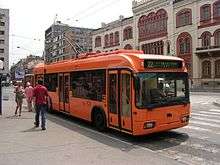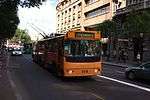Trolleybuses in Belgrade
 AKSM-321 in Banjica, in front of the Military Medical Academy | |
| Overview | |
|---|---|
| Owner | GSP Belgrade |
| Locale |
|
| Transit type | Trolleybus |
| Number of lines | 7 (daytime) |
| Website | GSP (in Serbian) |
| Operation | |
| Began operation | 22 June 1947 |
| Operator(s) | GSP Belgrade |
| Technical | |
| System length | Line length: 55.8 km (34.7 mi) |
| Electrification | 600 V DC |
The Belgrade trolleybus system forms part of the public transportation network in the city of Belgrade, the capital of Serbia. It is operated by the city-owned public transportation company GSP Belgrade. In 2017, the network consisted of 7 lines, with 125 trolleybuses operating on 55.8 km (34.7 mi) of two-way overhead wires.[1] Trola, Serbian name for the trolley pole, became among Belgraders the common, colloquial name for the trolleybus in general.
History
Background
The idea of introducing trolleybuses was considered during Interbellum. In the late 1930s, city's Directory for trams and lights prepared the acquisition of the first vehicles. The intention was to introduce the trolleybus lines which would connect the downtown Belgrade to Karaburma. World War II prevented the realization of this plan but the devastation of the tram infrastructure during the war revitalized the idea of trolleybuses.[2]
1947-1960s expansion
The first trolleybus was presented to the public during the Labor Day parade on 1 May 1947 while the network became operational on 22 June 1947. First two lines were Kalemegdan-Slavija and Crveni Krst-Slavija, which was later expanded to Kalemegdan, too. Several months later, the third line, to Dušanovac, was open. In the 1950s, the general idea was that trolleybuses should take over the major role in the public transportation. By 1955, the number of trolleybuses rose to 42. Envisioned plans included lines to Zemun, Karaburma, New Belgrade and Dedinje, but not all were carried into effect. Line to Zemun was opened in 1956, and in time three lines across the Sava river were formed: Line 14 – Zeleni Venac-Gornji Grad (Zemun) (which was considered a successor line to the pre-war tram line), Line 15 – Zeleni Venac-Novi Grad (Zemun) and Line 16 – Zeleni Venac-Pohorska, New Belgrade. [2]
During this period, trolleybus became part of the Belgrade’s sub-culture due to the activity of kešanje (slang for hanging onto something). Instead of entering the vehicle and paying for the ticket, the teenagers and young adults would grab onto the trolley pole on the outside.
1970s decline
Since the late 1960s, city authorities began to consider abolishing the trolleybus network completely. In 1973 all three lines across the river were terminated and by the ending of Branko Pešić’s tenure as the mayor of Belgrade in 1974, only one line survived, Kalemegdan-Kruševačka, Lekino Brdo. It was planned for it to be abolished, too, but already in the mid-1970s, after several types of research, city government changed the opinion and began developing the trolleybus network again.[2]
1980s revitalization
By the early 1980s, new neighborhoods planned to become part of the network were Konjarnik, Miljakovac, Učiteljsko Naselje, Medaković, Banjica, Kumodraž, and Zvezdara. By 1982 trolleybuses reached Konjarnik (Line 19) and Učiteljsko Naselje (Line 21) and the Line 28, connecting Kalemegdan to Zvezdara opened in 1983. In 1985 Line 41 connected Kalemegdan to Banjica II and in 1986 Line 40 was opened between Banjica II and Zvezdara. By the late 1980s, citizens became accustomed to the network and in the 1990s a new trolleybus depot was built in Dorćol, with the capacity of servicing 135 vehicles.[2]
Future
After new city government took over in 2013, an idea of abolishing the trolleybus network was raised again, partially prompted by the experimental introduction of the electric buses. Due to the possible creation of the pedestrian zone in the entire central section of Belgrade, propositions include the change of the routes in downtown, the relocation of the central terminus from Studentski Trg to Slavija and of the depo from Dorćol to Medaković. The remaining lines should connect the hilly parts of the city: Konjarnik, Medaković, Vračar, Banjica and Kanarevo Brdo.[2] City manager Goran Vesić announced that one single tram line will replace all four trolleybus lines (19, 21, 22 and 29) and the only bus line (31), which traverse through the city’s main street Kralja Milana. Regarding reasons, Vesić stated that the overhead lines look ugly in downtown and that citizen complained about the noise made by the trolleybuses. The immediate reaction of the citizens was mostly negative.[3][4] However, some of the advantages of the trolleybuses are their minimal noise pollution. Also, there is a matter of price of digging up the entire center of the city so that at least 6 km (3.7 mi) of tram tracks can be placed, and the cost of buying the new trams which will supposedly be operated on capacitors, without the grid. At the moment, five lines pass through the main street 47 times per hour.[5] On average, that is one vehicle on every 86 second, which is virtually impossible with only one line. In May 2017, Prime Minister of Serbia Aleksandar Vučić, even though the Belgrade's city transportation is completely outside of his jurisdiction, stated that he wants to abolish the trolleybus network completely and replace it with the electric buses. As a reason, he said that the trolleybuses are causing problems and that when one stops due to the malfunction, it stops the entire traffic behind it.[6] Though electric buses may be a better solution than the trams, Vučić's reasoning is dubious, just like the Vesić's. Trolleybus has easier traffic avoidance than a tram. Contrary to the trams, which indeed stops all the trams behind when one malfunction because they all use the same tracks when a trolleybus is broken, it is simply unhooked from the grid and is easily bypassed by the trolleybus behind it.
Lines
As of 2017, there are seven lines in operation. They operate every day, ona different timetable, depending on the time of the day or if it is a weekend. There are no night trolleybus lines.
| Number | Route (Neighborhoods) |
|---|---|
| 19 | Studentski Trg – Republic Square – Terazije – London – Slavija – Čubura – Crveni Krst – Šumice – Denkova Bašta – Konjarnik |
| 21 | Studentski Trg – Republic Square – Terazije – London – Slavija – Čubura – Crveni Krst – Šumice – Denkova Bašta – Učiteljsko Naselje |
| 22 | Studentski Trg – Republic Square – Terazije – London – Slavija – Čubura – Crveni Krst – Pašino Brdo – Kruševačka street |
| 28 | Studentski Trg – Republic Square – Stari Grad – Palilula – Hadžipopovac – Bulbulder – Zvezdara |
| 29 | Studentski Trg – Republic Square – Terazije – London – Slavija – Čubura – Crveni Krst – Šumice – Denkova Bašta – Konjarnik – Medaković II – Padina – Medaković III |
| 40 | Zvezdara – Bulbuder – Hadžipopovac – Palilula – Andrićev Venac – London – Savski Venac – Zapadni Vračar – Mostar – Senjak – Prokop – Dedinje – Banjica – Banjica II |
| 41 | Studentski Trg – Republic Square – Stari Grad – Andrićev Venac – London – Savski Venac – Zapadni Vračar – Mostar – Senjak – Prokop – Dedinje – Banjica – Banjica II |
Some of the recently abolished lines include Line 22L, which operated from Kalemegdan to Slavija, as the shortest line of the public transportation in Belgrade (2.5 km (1.6 mi)) which was abolished on 3 September 2012, and Line 29N, night line which was abolished in 2006 and replaced by the bus.
The fleet
In 2012, when the fleet numbered 133 vehicles, the breakdown by the type was:
- AKSM-321 – 93 vehicles
- AKSM-333 – 12 vehicles
- TrolZa-62052.01 – 12 vehicles
- AKSM-201 – 10 vehicles
- ZiU-9 – 4 vehicles
- VMZ-5298.00 – 1 vehicle
- TrolZa-5275.05 Optima – 1 vehicle
Former types included:
- FIAT 668F – 31 vehicle (introduced in 1947)
- Alfa Romeo 140AF – 12 vehicles (1949)
- Goša I – 40 vehicles (1956) (domestic production)
- Goša II – 38 vehicles (1957–58) (domestic production)
- FAGES 63 – 60 vehicles (1964–65) (domestic production)
- Gräf & Stift GE 112 M 16 – 3 vehicles (2003) (donation by the city of Salzburg)
- Gräf & Stift GOE 112 M 11 – 2 vehicles (2003) (donation by the city of Salzburg)
Photos
|
See also
References
- ↑ "GSP Beograd – statistika" (in Serbian). GSP Beograd. 2016.
- 1 2 3 4 5 Dejan Aleksić (2 May 2017), "„Trole" vozile Novobeograđane i Zemunce", Politika (in Serbian), p. 31
- ↑ FoNet (26 November 2016), "Ponovo tramvaj od Slavije preko Terazija do Kalemegdana", N1 (in Serbian)
- ↑ Dejan Aleksić (4 December 2016), "I „za" i „protiv" vraćanja „jedinice" u centar", Politika (in Serbian)
- ↑ Dejan Aleksić (20 December 2016), "Širenje tramvajske mreže ne ometa gradnju metroa", Politika (in Serbian)
- ↑ Tanjug (14 May 2017), "Vučić: Da ukinemo trolejbuse, prave nam problem", B92 (in Serbian)













